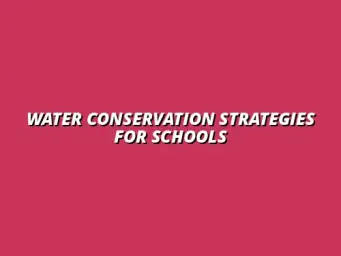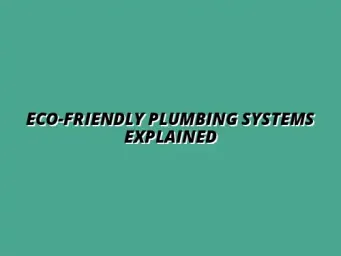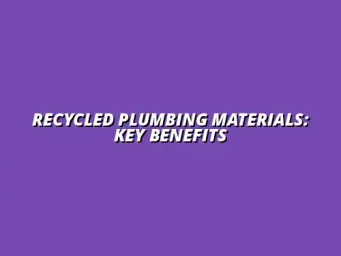Understanding Eco Plumbing Systems in Green Building
When we talk about eco plumbing systems, we're diving into a specialized area of plumbing that focuses on sustainability and efficiency. These systems are designed to minimize water and energy use, making them essential for any green building project. By adopting eco plumbing practices, we can significantly reduce our environmental footprint while promoting healthier living spaces. For new builds, consider eco-friendly plumbing options from the outset.
Eco plumbing isn’t just about using less water; it’s about creating a holistic approach to plumbing systems that supports the principles of sustainability. This includes everything from choosing materials that have a low environmental impact to implementing technologies that recycle water. Understanding these systems is crucial for anyone involved in green building, whether you're an architect, builder, or homeowner.
Definition and Importance of Eco Plumbing Systems
What are Eco Plumbing Systems?
Eco plumbing systems integrate various technologies and practices that prioritize the efficient use of water and energy. At their core, these systems aim to reduce waste and promote conservation. Some key features include low-flow fixtures, rainwater harvesting systems, and greywater recycling. This innovative approach not only benefits the environment but also enhances the overall efficiency of a building. Learn more about saving water in your bathroom with these helpful bathroom plumbing tips.
By understanding what eco plumbing systems are, we can appreciate their significance in today’s construction landscape. They align perfectly with the goals of green building, which seeks to create structures that are not only functional but also environmentally friendly. As we move towards a more sustainable future, eco plumbing plays a pivotal role in achieving these goals.
The Role of Eco Plumbing in Sustainable Building Practices
The adoption of eco plumbing systems is critical for sustainable building practices. These systems contribute to the overall goal of reducing the ecological impact of buildings. Some specific roles include:
- Water conservation: Eco plumbing helps in using less water, which is vital in areas facing water scarcity.
- Energy efficiency: Efficient plumbing systems reduce the energy needed for heating water. Prevent costly water heater leaks with these simple maintenance tips.
- Improved health outcomes: Sustainable practices contribute to better indoor air quality and overall health.
By implementing eco plumbing, we take an active step towards building a more sustainable future. Each system we install has the potential to make a lasting positive impact on our environment and community. And saving water while washing dishes is easier than you think, check out these water saving tips!
Key Components of Eco Plumbing Systems
Water Conservation Technologies
One of the primary goals of eco plumbing systems is to conserve water. Various technologies are available to help achieve this goal, including:
- Low-flow faucets and showerheads
- Dual-flush toilets
- Smart irrigation systems
These technologies are designed to reduce water usage without sacrificing performance. By incorporating them into our plumbing systems, we can significantly lower our water bills while also being kinder to the planet! If you have a leaky kitchen faucet, here’s how to fix a leaky kitchen faucet.
Energy-Efficient Appliances and Fixtures
In addition to conserving water, eco plumbing systems often include energy-efficient appliances and fixtures. These tools aim to provide the same level of comfort and functionality while using less energy. Examples include:
- Energy Star-rated dishwashers and washing machines
- Heat pump water heaters
- LED lighting fixtures in bathrooms and kitchens
Using energy-efficient appliances not only reduces utility bills but also contributes to a more sustainable lifestyle. It's a win-win situation for homeowners and the environment!
Alternative Water Sources and Recycling
Utilizing alternative water sources is another key component of eco plumbing systems. This includes systems that capture and reuse rainwater or greywater. The benefits of these practices are multi-fold:
- Decreasing reliance on municipal water supplies
- Reducing stormwater runoff
- Providing a sustainable water source for irrigation and non-potable uses
By embracing these practices, we are taking significant strides towards sustainable water management. It's not just about cutting costs; it's about being responsible stewards of our natural resources! For more information on eco-plumbing for green homes, visit this page.
Common Questions About Eco Plumbing Systems
What Types of Technologies Are Available?
When it comes to eco plumbing systems, there are several innovative technologies available that promote water efficiency. These technologies are designed to reduce water consumption while maintaining the necessary performance standards for plumbing systems. By opting for these solutions, homeowners can not only save on water bills but also contribute to a more sustainable future.
Some of the most popular technologies include:
- Low-flow faucets and showerheads: These fixtures significantly reduce water flow without compromising pressure.
- Dual-flush toilets: Offering two flushing options, these toilets save water by allowing users to choose a lighter flush for liquid waste.
- Rainwater harvesting systems: These systems collect and store rainwater for non-potable uses, such as irrigation.
- Greywater recycling systems: These technologies treat wastewater from sinks and showers for reuse in irrigation or toilet flushing.
Innovative Solutions for Water Efficiency
Innovative solutions are constantly evolving, making eco plumbing even more effective. For instance, smart technologies can enhance water management by providing real-time data on usage. These systems can alert homeowners to leaks or unusual patterns, ensuring quick responses that save both water and money!
Some emerging technologies to consider include:
- Smart meters: These devices track water usage and can be monitored through mobile apps.
- Leak detection systems: Advanced sensors can identify leaks and notify homeowners immediately.
- IoT-enabled appliances: Smart appliances can optimize their water use based on available data.
How to Choose an Eco Plumbing Contractor?
When selecting an eco plumbing contractor, it's essential to consider their qualifications and experience. You want someone who understands the specific needs of eco plumbing and adheres to sustainable practices. By choosing the right contractor, you can ensure that your plumbing upgrades will be effective and compliant with green building standards. For plumbing services in Billesley, Birmingham, consider contacting a local plumber.
Here are the key qualifications to look for:
- Certifications: Look for certifications related to green building practices, such as LEED or WaterSense.
- Experience: A contractor with a proven track record in eco plumbing projects is more likely to deliver satisfactory results.
- References: Request referrals from past clients to gauge their satisfaction with the contractor's services.
Key Qualifications and Certifications to Look For
In addition to certifications, you should also evaluate the contractor's knowledge of local regulations and their commitment to eco-friendly practices. This knowledge ensures that your plumbing system adheres to all necessary guidelines, which can save you from costly mistakes down the line.
Some qualifications and certifications to consider include:
- GreenPlumber® certification: This program focuses on water-saving techniques and sustainable plumbing practices.
- Plumbing and Mechanical Professionals (PMP) certification: Validates their understanding of plumbing systems and regulations.
- Local green building certifications: Ensure they are familiar with standards specific to your area.
Practical Steps for Implementing Eco Plumbing Systems
Implementing eco plumbing systems starts with a thorough assessment of the current plumbing infrastructure. Understanding your existing systems is crucial for identifying potential improvements. This way, you can target areas that need upgrades to make your plumbing more efficient and sustainable.
A good first step is to conduct a water usage audit. This audit helps you evaluate how much water your household uses and where it can be conserved. By tracking usage, you can spot patterns and areas of excessive consumption.
Conducting a Water Usage Audit
To conduct an effective water audit, consider following these steps:
- Record monthly water bills: Look for changes in usage over time.
- Check for leaks: Inspect all faucets and fixtures for drips or leaks.
- Assess irrigation systems: Determine if you are over-watering your garden or yard.
- Evaluate appliance efficiency: Review the water efficiency of appliances like dishwashers and washing machines.
After identifying areas for improvement, you can create a plan for upgrades and enhancements.
Future-Proofing Your Eco Plumbing System
To ensure lasting success, it's essential to future-proof your eco plumbing system. This involves adapting to emerging technologies and trends in sustainable building practices. By staying ahead of the curve, you can maintain efficiency and compliance without frequent, costly overhauls.
One practical approach is to stay informed about new products and technologies that can enhance your plumbing system. Regularly reviewing industry news and advancements can help you identify potential upgrades.
Adapting to Emerging Technologies and Standards
Some strategies for future-proofing include:
- Regular training: Keep your plumbing contractor updated on the latest eco-friendly solutions.
- Integrating smart technology: Consider installing smart plumbing systems that can adapt to changing usage patterns.
- Participating in workshops: Attend local workshops or seminars focused on sustainable practices.
Final Thoughts on Eco Plumbing Systems in Green Building
Implementing eco plumbing systems offers numerous benefits for both homeowners and the environment. By investing in these systems, you contribute to a more sustainable future while also potentially reducing your utility bills.
As we transition to more eco-friendly practices, it's essential to stay informed and take actionable steps. This can lead to lasting impacts on both your household and the larger community.
Resources for Further Education and Implementation
For those interested in learning more about eco plumbing and sustainability, several resources are available:
- Online courses: Platforms like Coursera and Udemy offer courses on sustainable building practices.
- Books: Titles focused on eco-friendly home improvements can provide valuable insights.
- Local workshops: Community organizations often host events about green living and conservation.
By exploring these resources, you can deepen your understanding of eco plumbing and take tangible steps toward a more sustainable lifestyle!









